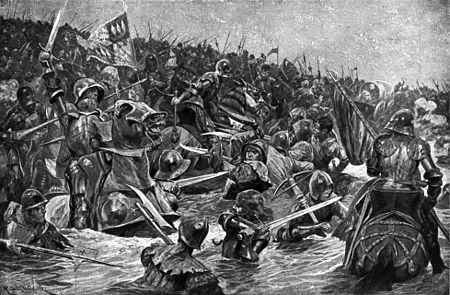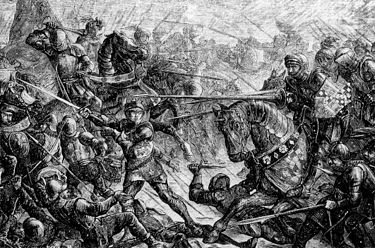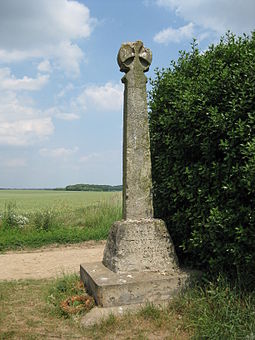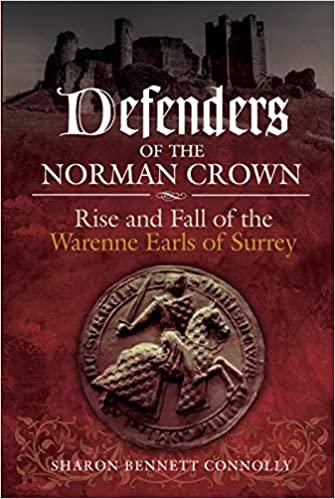Today it is a pleasure to welcome author and historian Dan Moorhouse to the blog with an article on the Battle of Towton, which was fought during the Wars of the Roses, on this day in 1461. Dan’s latest book, On this Day in the Wars of the Roses, is a fabulous read, looking into the Wars of the Roses in a whole new way. Over to Dan…
7 things you may not know about the Battle of Towton
The Battle of Towton is often described as being the biggest, bloodiest battle of English history. Heralds at the time suggested 28,000 dead. Towton established Edward IV as king. His coronation was shortly afterwards. Yet much of what is known about the Battle of Towton is not well known. Dan Moorhouse outlines 7 areas that help to put the battle into perspective.
- Battlefield Executions
In the aftermath of the battle, several of the defeated Lancastrians were rounded up and summarily executed. Evidence for this comes in the form of human remains excavated near Towton Hall. The bodies bore wounds to the head, neck, shoulders. But none to the arms, indicating that these men had been unable to defend themselves. 42 such executions are known to have taken place on the battlefield. This is not the only example of summary justice being meted out following Towton. In York, the victorious Yorkists discovered more Lancastrians. In the days that followed, other men were executed on Edward IVs orders, including the Earl of Devon. A grave pit has been excavated on the Knavesmire, where public executions took place outside York, which contained the remains of bodies that had been beheaded. These have been carbon dated to the period.
- Survivors
Whilst there is much speculation about the number of Lancastrian dead, there is less said about those who survived. The Royal family had been in the relative safety of York. Most leading nobles escaped the battlefield. With so many dead, many fleeing and wintery conditions, the survivor’s stories varied greatly. Robert Bolling (Bradford, Yorks.) was believed to have died. This remained the case in November when he was posthumously attained. However, he had survived and spent the next 14 years trying to overturn the attainder. Thomas Denys wrote that ‘There I lost £20 worth, bone, harness and money and was hurt in divers places.’ In other words, he was injured, without transport and had lost or spent all his money.
- Hiding
It is well known that Henry VI went into hiding and was eventually captured near Clitheroe several years later. That other non-combatants did the same is less well known. Henry Clifford was the son of John 9th Baron Clifford. Following his father’s death (at Dintingdale), he too went into hiding. Legend has it that he hid with Shepherd’s in the Yorkshire Dales until after the Battle of Bosworth! This stems from an account written by Lady Anne Clifford in the 17th century. The story seems more myth than factual, though. Though still a child, he is known to have signed charters just a few years later. During the readeption, Lord Montagu was granted the wardship of Henry Clifford. Edward IV pardoned him in 1472, and he was permitted to access his inheritance from his maternal grandfather at that point. However, he did not receive his Clifford inheritance until 1493.
- Death toll
The Battle of Towton was big, of that there is no doubt. What there is doubt over is how big. Figures for medieval battles vary significantly in their accuracy. For campaigns in the Hundred Years War, there are centrally held records, many of which survive. These make numbers reasonable accurate. For battles in the first phase of the Wars of the Roses, this is not the case. Sources include Heralds, various chronicles, letters, muster rolls and ambassadorial dispatches. Archaeological analysis provides further evidence, as does an examination of logistics. The problem is, none are definitive, and they vary greatly. Chroniclers were prone to exaggeration, as seen by numbers that run from 9000 to 120000 Lancastrian dead. Heralds suggested 28000 dead. Letters and dispatches also disagree. Modern analysis suggests an upper figure of 10000, based on the battlefield’s size, number of nobles and knights known to have fought and the logistics involved in the campaigns. An analysis by The History of Parliament shows that of the peerage and members of Parliament known to have fought, as little as 20%, mainly Lancastrian, perished. With estimates suggesting around 55000 participants, this would be consistent with a death toll of around the 10000 mark.
- Finds
It may seem strange that there is no extensive collection of finds from such a significant battle. This is because most substantial items would have been scavenged in the hours, days and weeks following the clash. Battlefield Metal Detector Simon Richardson worked on the Towton battlefield for 32 years. His collection of finds does amass to over one thousand items. Primarily these are small items such as buckles and straps. However, he also discovered fragments of the ‘Towton gun’, the oldest handgun to have been excavated in the British Isles. Sections of a brass cannon were found. Evidence suggests that it exploded on being fired with the probable loss of life of those around it. Richardson also aided in the excavation of a memorial chantry built in the reign of Richard III.
- Pursuit
The rout at the Battle of Towton is well recorded. Cock Beck was awash with blood. Bodies were used as a bridge by men fleeing the hail of arrows. Those fleeing in a different direction were prone to being run down by Cavalry. As the Lancastrian lines broke, the Yorkists could simply pick off those in flight. Whilst there is ample evidence of slaughter at these places, it is often forgotten that the rout went on for some distance and time. George Neville, in his letter to Francesco Coppini, placed more emphasis on slaughters away from the battlefield than in the immediate rout:
“At the town of Tadcaster, eight miles from York, very many of the fugitives were drowned in the river, the enemy having themselves broken the bridge in their rear beforehand. Of the remainder who escaped for the moment a great part were killed in that town, and in the city [of York]; and quite lately one might have still seen the bodies of these unfortunate men lying unburied, over a space nearly six miles in length and three or four furlongs broad”. [British History Online: Calendar of state papers relating to English affairs in the Archives of Venice, vol 1: 1202-1509]
- Memorials
Many of the men who died were local and on the losing side. Despite the new regime, there is evidence that their loss was memorialised at the time, under the victors’ watchful gaze and in rather lavish or unusual fashion. The unusual is the Tomb of Lord Dacre. The tomb itself looks unremarkable. It is close to the battlefield and in keeping with tombs of the period. What is odd is the story that he was buried on his horse. Perhaps a legend, it has not been disproven. Lionel, Lord Welles, was one of the most senior Lancastrians to die in the battle and married to Margaret Beauchamp, mother by her first marriage to Margaret Beaufort. Despite his links to the Lancastrian line, his body was interred at Methley, Yorkshire, with an ornate alabaster effigy. Other memorials were added during the Wars of the Roses and in later centuries.
My thanks to Dan for an interesting and entertaining article, and my congratulations of the release of On this Day in the Wars of the Roses. The book is out now and available from Amazon UK and Amazon US.
*
About the author
Dan Moorhouse’s interest in history initially led him into teaching, and writing about the history of Medicine for Hodder Murray, an imprint of Harcourt. His work includes contributions to numerous print and online publications, including for the BBC, Guardian, Times, and a range of national and local museums. As a member of the Historical Association, Dan served on the Education Committee for a decade and helped to re-establish the society in West Yorkshire. Dan is also a keen member of the Battlefields Trust and Richard III Societies. Dan’s interest in the Wars of the Roses was sparked at an early age. He grew up close to the seat of the notorious Clifford family and several major battlefields. He has studied the Wars of the Roses to Masters Degree Level and writes regularly about the subject for a general audience via his website and social media channels.
Links:
Website – https://schoolshistory.org.uk/
The Battle of Towton – https://schoolshistory.org.uk/topics/british-history/wars-of-the-roses/battle-of-towton/
*
My books
Coming 31st May:
Defenders of the Norman Crown: The Rise and Fall of the Warenne Earls of Surrey tells the fascinating story of the Warenne dynasty, of the successes and failures of one of the most powerful families in England, from its origins in Normandy, through the Conquest, Magna Carta, the wars and marriages that led to its ultimate demise in the reign of Edward III.
Defenders of the Norman Crown: Rise and Fall of the Warenne Earls of Surrey will be released in the UK on 31 May and in the US on 6 August. And it is now available for pre-order from Pen & Sword Books, Amazon in the UK and US and Book Depository.
Also by Sharon Bennett Connolly:
Ladies of Magna Carta: Women of Influence in Thirteenth Century England looks into the relationships of the various noble families of the 13th century, and how they were affected by the Barons’ Wars, Magna Carta and its aftermath; the bonds that were formed and those that were broken. It is now available from Pen & Sword, Amazon and from Book Depository worldwide.
Heroines of the Medieval World tells the stories of some of the most remarkable women from Medieval history, from Eleanor of Aquitaine to Julian of Norwich. Available now from Amberley Publishing and Amazon and Book Depository.
Silk and the Sword: The Women of the Norman Conquest traces the fortunes of the women who had a significant role to play in the momentous events of 1066. Available now from Amazon, Amberley Publishing, Book Depository.
You can be the first to read new articles by clicking the ‘Follow’ button, liking our Facebook page or joining me on Twitter and Instagram.
©2021 Sharon Bennett Connolly and Dan Moorhouse






Such an atmospheric place even now.
LikeLiked by 1 person
Totally agree John. I’ve been on a few battlefields. They all have something eerie and otherworldly about them, but none have an atmosphere quite like Towton.
LikeLiked by 1 person
I thought Edgehill had a very similar atmosphere.
LikeLiked by 1 person
I haven’t been to Edgehill yet. I tend to find the battlefields with the least amount of interpretation have the greatest atmospheres. Waterloo was too busy and Bosworth is too structured. Whereas sites like Towton and Flodden allow you to let your own eyes and imagination interpret the field.
LikeLiked by 1 person
Must be 40 years since I was at Edgehill, and the MoD had much of it then. I found Peter Young’s book on the battle a great help.
LikeLike